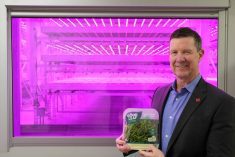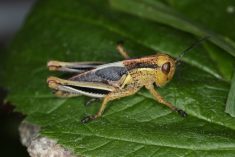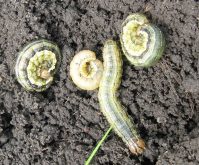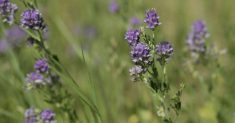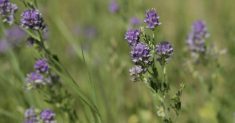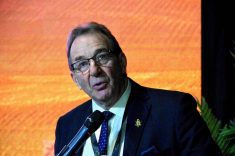This year’s alfalfa hay harvest could be the earliest in years, according to J. W. Schroeder, North Dakota State University Extension Service dairy specialist.
Seeding surveys indicate that, unlike in the last five to six years, crops and forages are ahead of schedule this year.
“Naturally, the weather in the next few days could change that, but all indications at this point suggest that you could be done seeding early this year,” Schroeder says. “However, that doesn’t mean you have more time to put up forage, especially good-quality alfalfa for dairy cows.”
Read Also

Manitoba sclerotinia picture mixed for 2025
Variations in weather and crop development in this year’s Manitoba canola fields make blanket sclerotinia outlooks hard to pin down
MULTI-FACETED DECISION
Many factors, such as environmental conditions, other field work and insect infestations, enter into the decision of when to harvest alfalfa. But for dairy quality or prime alfalfa hay, height should be your guide, Schroeder advises.
“For years, we made forage harvest decisions based on plant maturity or calendar date,” he says. “Today plant height is more important in determining when to harvest first-cutting alfalfa than plant maturity and calendar date. Forage quality, digestibility and intake potential decrease with increasing maturity.”
A variable growing season changes the optimum time to take the first cutting from year to year, says Dwain Meyer, a professor and the interim chair of NDSU’s plant sciences department. If spring is late and the temperature average is below normal, high-quality hay can be obtained by harvesting alfalfa at a later maturity stage, such as late bud to early bloom. For example, in 2008, the Red River Valley harvest started June 16.
However, if spring is early and above normal in temperature, the optimum harvest date will be earlier, as it was in 2002, when the first harvest was May 24.
PLANT HEIGHT BEST INDICATOR
Plant height is the best indicator of when to take the first harvest because relative feed value (RFV ) and relative forage quality (RFQ) decrease as the plant height increases. The RFV decreases with increasing plant height at all maturity stages. For example, the RFV decreases 71 units at the late vegetative stage, 61 units at late-bud stage and 53 units at the late-flower stage when alfalfa increases from 20 to 40 inches in height. Therefore, the taller the plant, the earlier in plant maturity that harvest should occur to get prime hay (RFV greater than 151) in the bale.
According to NDSU research, harvest should begin whenever the alfalfa reaches about 28 inches in height, regardless of the maturity stage.
“If prime hay for feed or sale is the objective, then that means you need to get ready for an early start on the harvest in 2010,” Schroeder says. “But keep your target in mind, and be sure to allow another 25 to 30 units of RFV for harvesting losses. In other words, harvest will have to begin at 175 to 180 RFV to meet your target.”
STICK MEASURES
The best method to estimate the RFV or RFQ in the first harvest is to use a PEAQ (Predictive Equations for Alfalfa Quality) stick available for purchase from the Midwest Forage Association (go to http://www.midwestforage.org/peaq.pdf), he says. It basically is a method to predict the forage quality of standing alfalfa using a calibrated stick.
Soil type and topography commonly affect height and maturity. Thus, alfalfa on hilltops has less growth and is more advanced in maturity than plants in lower, wetter areas of the field. Schroeder recommends basing harvesting decisions on the growth in the valleys because the short growth and more advanced maturity on the hilltops will not affect the quality extensively.
“Assuming that Mother Nature will provide ample moisture for subsequent forage harvests, keep in mind that second and third harvests are generally shorter in height than the first,” he says. “Therefore, the optimum maturity stage at harvest for these will be more advanced than the first harvest.”
The first harvest is always the most variable in maturity and, therefore, the least predictable, he notes. NDSU forage research found that under a four-cut system, the maturity at harvest generally is mid-to late-bud stage and occasionally 80 per cent bloom stage (under drought stress) in the second harvest and 10 to 20 per cent bloom stage in the third harvest or later under drought stress.
LATE AFTERNOON
Once producers decide when to harvest, they also need to consider the time of day for the harvest. Research has shown that harvesting in late afternoon or early evening produces a forage with a higher total nonstructural carbohydrate content than one harvested in the morning due to the current day’s photosynthesis. Higher carbohydrate levels in the plant will increase digestibility, resulting in improved animal performance.
While plant height and scissor-cutting reports from your area, if available, are the best indicators of when to start harvesting, do not leave plant maturity out of the harvesting decision, Schroeder says.
If the alfalfa is for lactating dairy cows, it should be harvested at about 160 RFV, or when it has about a 37 to 38 per cent neutral detergent fibre (NDF). The crude protein content in alfalfa of this quality will be about 20 per cent. For wet forages, the haylage dry matter of 40 to 45 per cent is ideal.
EARLY HARVEST
Since all indications are this spring will stay warm, plant maturity/ height will sneak up on us faster than expected.”
Schroeder also offers these notes of caution: The relationship between height and quality was developed in pure alfalfa stands, so quality estimates in alfalfa-grass fields based on just alfalfa will be less reliable. Furthermore, frost still is possible. The good news is that a light frost (29 F) is not a concern. However, if temperatures get below 23 F, then losses would be likely.






